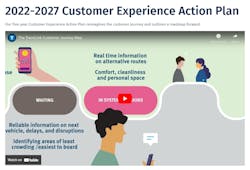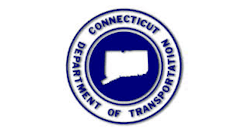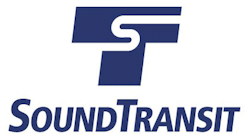Diverse strategies in customer experience programs across North America help increase ridership, improve morale
As with many other industries, customer experience (CX) programs are taking transit by storm. All across North America, transit agencies are launching CX programs to improve customer satisfaction, attract riders and improve morale. More than 20 transit agencies in all have embarked on a CX journey in the U.S. and Canada.
Here is a roundup of some of the more notable programs.
Los Angeles County Metropolitan Transportation Authority (L.A. Metro) launched its CX Program in 2020 to sharpen its focus on customers. L.A. Metro conducts CX surveys to identify top pain points and creates CX Plans to remedy the issues. Its most recent CX Plan tackles cleanliness, public safety, bus stop shade and seating, customer information, time competitiveness and the diverse needs of diverse riders. To date, the L.A. Metro CX Plans have spawned nearly 100 initiatives and more than $200 million in investments to improve the customer experience. One of the initiatives is to deploy hundreds of transit ambassadors on the system to enhance safety and help customers. Beyond the annual CX plans, the L.A. program has tracts for improving CX culture, establishing Key Experience Indicators (KEIs) and institutionalizing CX into budgeting, capital investments, performance appraisals and other processes. It also plays a key role in preparing L.A. Metro to welcome visitors around the world for the 2028 Olympics and Paralympics events and to provide them with an excellent customer experience.
Metropolitan Atlanta Rapid Transit Authority (MARTA) in Atlanta also has an extensive CX program. It named its first chief customer experience officer (CXO) in 2020 to elevate customer voices and prioritize the customer experience in MARTA’s operations and capital program. The MARTA CXO is certified as a customer experience professional (CCXP) by the Customer Experience Professionals Association (CXPA) and serves as an internal customer advocate, partnering with leaders across all business units to ensure that customers are at the center of business decisions. The MARTA CX team includes units for innovation, customer services, sustainability and customer insights. It also oversees a Riders’ Advisory Council, homeless outreach, transit ambassadors and special events planning. MARTA incorporated multiple CX improvements in its FY23 budget, including improvements to fare collection and customer information and a SMART restroom program that will alert staff when supplies are low or the space needs cleaning.
Southeastern Pennsylvania Transportation Authority (SEPTA) in Philadelphia also has an active CX program. The SEPTA CX team advocates on behalf of SEPTA customers, conducting surveys and focus groups, bringing customers into decision-making processes, listening carefully and maintaining standards for timely response to customer feedback. Key focal points are providing accurate real-time information, injecting art and entertainment into the passenger experience and meeting the needs of the diverse customers who ride SEPTA. Internally, the SEPTA CX team promotes the idea that all employees own the customer experience and that every team member is providing essential internal service (to other employees) or external service (to paying customers).
Sound Transit in Seattle has also joined the CX movement. It appointed its first chief passenger experience officer in 2018, who acts as an advocate for passengers across the agency. The CX research and innovation team deploys and tests new technologies, conducts passenger research and uses research results to improve the passenger experience. A CX wayfinding and signage team ensures that signs are simple, seamless and intuitive. A passenger care team provides customer support, sends rider alerts and manages accessibility services. And a passenger success team is responsible for the agency’s fare ambassador program and helps support passengers in crisis and/or experiencing homelessness.
Community Transit in Washington state hired its first CX director in 2016. They compile information on the voice of the customer and test innovative approaches to meeting their needs. They also work to create a seamless experience across their region and train employees to practice walking in a customer's shoes.
Earlier this year, the Connecticut Department of Transportation (CTDOT) launched a CX website to invite input from riders and plans to finalize its first CX Action Plan by early 2023. CTDOT has used social media, stakeholder interviews, community meetings and townhall events, surveys of customers and front-line employees, focus groups and pop-up events at transit facilities. The goal is to make transit a more comfortable, reliable and efficient experience for everyone.
Trinity Metro in Fort Worth, Texas, is another agency with a budding CX program. It includes travel training, deploying Transit ENVOYs at transfer centers and rail stations to assist customers.
Other transit agencies that have CX staff include Capital Area Transportation Authority (CATA), Utah Transit Authority (UTA), Central Ohio Transit Authority (COTA), Metrolink in Southern California, Massachusetts Bay Transportation Authority in Boston, Honolulu, Dallas Area Rapid Transit in Dallas, TriMet in Portland, Ore., and New York Metropolitan Transportation Authority.
Also, San Francisco Municipal Transportation Agency included a new CX program in its most recent budget - so stay tuned!
Transit is not alone in establishing CX programs to improve the delivery of government services. The growth of CX in public transit is part of a broader trend to make government services more user-friendly. Even the White House has a comprehensive CX program.
CX is a tough business. It requires organizational and cultural changes that can take transit agencies out of their comfort zones. As transit CX continues to develop in America, it will be essential to get buy-in at all levels, provide CX staff with the resources and clout needed to accomplish changes and continue an obsessive focus on customer experiences to overcome the many obstacles to change. America's transit agencies are off to a good start as they build diverse CX programs - each with their own flavor and focus. The industry will watch to see which organizational models have the most impact over the next few years as transit works to recover ridership, improve access to opportunity for disadvantaged populations and combat climate change.
------
Aaron Weinstein is an executive consultant, customer experience and founder of Transit CX and former executive officer, customer experience at L.A. Metro.








